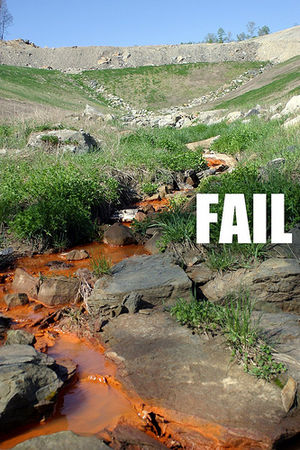Acid mine drainage
|
This article is part of the Coal Issues portal on SourceWatch, a project of Global Energy Monitor and the Center for Media and Democracy. See here for help on adding material to CoalSwarm. |
Acid mine drainage (AMD) refers to the outflow of acidic water from coal or metal mines, often abandoned ones where ore- or coal mining activities have exposed rocks containing the sulphur-bearing mineral pyrite. Pyrite reacts with air and water to form sulphuric acid and dissolved iron, and as water washes through mines, this compound forms a dilute acid, which can wash into nearby rivers and streams.[1]
Contents
Environmental and Health Effects
Bright orange-colored water and stained rocks are usually signs of AMD. The orange color is caused by ferric hydroxide precipitating out of the water, which forms as the AMD becomes neutralized. At low pH values, the metal ions remain soluble, and when the pH rises, the iron oxidizes and precipitates out. Depending on the conditions, the orange-colored precipitates may form inside the mine or several miles downstream, and can be harmful to aquatic life: the clumps reduce the amount of light that can penetrate the water, affecting photosynthesis and visibility for animal life. Also, as the precipitate settles it blankets the stream bed, smothering the bottom-dwellers and their food resources.[2]
Water discharging from deep-mine openings and surface mine seeps results in elevated concentrations of acidity, iron, manganese, aluminum, and sulfate in receiving streams and rivers, depleting the buffering ability of water by neutralizing the carbonate and bicarbonate ions that form carbonic acid. Streams and rivers with low buffer capacity are not able to neutralize the acid load and consequently become acidic. An estimated 2,390 miles of streams in the Allegheny and Monongahela River Basins have been degraded by AMD to the point of not being able to support fish communities.[3]
Production of AMD can occur long after mines have been abandoned if piles of waste rock are in contact with air and water, and this effluent can be a large water quality problem for river and stream ecosystems for states with a history of coal mining, such as West Virginia and Pennsylvania. AMD dissolves heavy metals such as copper, lead, and mercury into ground and surface water.[2]
Treatment and Coal Waste
Active treatment involves installing a water treatment plant, where the AMD is dosed with lime to try and neutralize the acid, and then passed through settling tanks to remove the sediment and particulate metals, creating coal waste.[1]
Resources
References
- ↑ 1.0 1.1 "Coal mining and the environment: Acid Mine Drainage" World Coal Institute, accessed June 2010.
- ↑ 2.0 2.1 "Acid Mine Drainage: Chemistry" Center for Educational Technologies, accessed June 2010.
- ↑ James I. Sams III and Kevin M. Beer, "Effects of Coal-Mine Drainage on Stream Water Quality in the Allegheny and Monongahela River Basins—Sulfate Transport and Trends" U.S. Department of the Interior Water-Resources Investigations Report 99-4208, 2000.
Related SourceWatch articles
- Air pollution from coal-fired power plants
- Clean Air Interstate Rule
- Climate impacts of coal plants
- Coal plants near residential areas
- Coal sludge
- Coal waste
- Colombia and coal
- Compliance coal
- Dispelling the myths of the acid rain story
- Environmental impacts of coal
- Estimating the amount of land disturbed by coal mining
- Estimating U.S. Government Subsidies to Energy Sources 2002-2008
- Existing U.S. Coal Plants
- Federal coal subsidies
- Fly ash
- Global use and production of coal
- Global warming
- Health effects of coal
- Indonesia and coal
- Low sulphur coal
- Major coal mines in the United States
- Mercury and coal
- Natural gas transmission leakage rates
- Retrofit vs. Phase-Out of Coal-Fired Power Plants
- Scrubber Retrofits at Existing Coal Plants
- State coal subsidies
- Sulphur and coal
- United States and coal
- Very low sulphur coal

